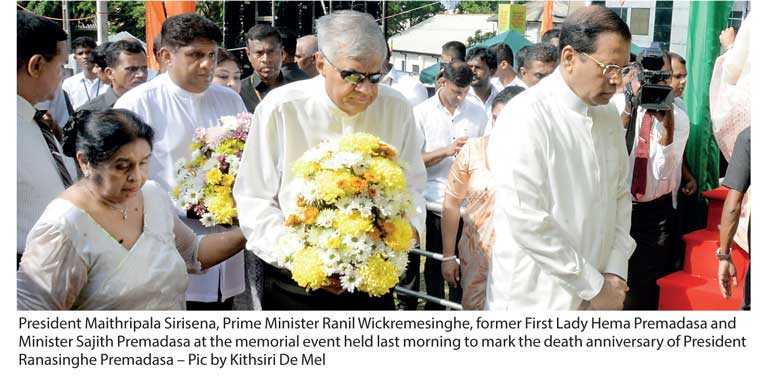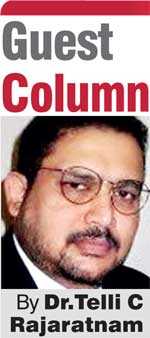Monday Apr 07, 2025
Monday Apr 07, 2025
Wednesday, 2 May 2018 00:00 - - {{hitsCtrl.values.hits}}


Ranasinghe Premadasa was born on 23 June 1924 in Colombo. He completed his education at St. Joseph’s College, Colombo 10. He was interested in social service for the welfare of the poor and downtrodden. He was the architect of the Sri Sucharitha Movement, an organisation with the objectives of uplifting the economic, social and spiritual development of the low income people. These youth who enrolled in his development movement refrained from taking liquor and avoided smoking and gambling. R. Premadasa too was a teetotaller.
He had been the Deputy Mayor of the Colombo Municipal Council. He was elected second Member of Parliament at the general election held in 1965 for the same seat and was appointed Chief Government Whip besides being appointed Parliamentary Secretary of Local Government. Later he was raised to the position of Minister of Local Government. In the following general election held in 1970, he was elected first MP for Colombo Central and sat in the Opposition with late J.R. Jayewardene, the Leader of the Opposition.
Premadasa was elected first MP for Colombo Central in 1977 and became the Leader of the House and the Minister of Local Government. He was appointed the Deputy Leader of the UNP. When J.R. Jayewardene became the first Executive President of the country, Minister Premadasa became the Prime Minister on 23 February 1978.
Part of his political program was shelter for the poor, after the United Nations declared a Year of Shelter. Other policies included Janasaviya, the instrument he used to help the poor, a foster parents scheme, the Gam Udawa project, the mobile secretariat whereby he took the Central Government bureaucracy to the peasants, the Tower Hall Foundation for drama and music, and the pension schemes he initiated for the elder artistes. On the economic front, the garment industry project that he initiated became a forerunner in earning foreign exchange and provision of employment in the villages.
He was elected second Executive President of the country when late J. R. Jayewardene stepped down. He led the UNP to victory at the general election held in 1989. He survived the attempted impeachment by some of his party men together with opposition Members of Parliament. He focussed on building the economy, in which exercise too he was successful as seen by the improved position of the country’s economy during his tenure.
However, Premadasa’s greatest achievements were in the field of housing, poverty alleviation and the upliftment of the downtrodden. He was the architect of many innovative development schemes, such as, the Gam Udawa, Presidential Mobile Service, 200 Garment Factories programs amongst others.
Premadasa proposed at the United Nations Organization in New York to declare a year as International Year of Shelter for the Homeless. The proposal was unanimously accepted at the 37th session of the United Nations General Assembly and 1987 was declared the International Year of Shelter for the Homeless.
He launched the Gam Udawa scheme all over the country. He was the founder of the Janasaviya, now the Samurdhi scheme.
During his presidency Premadasa took action to reduce poverty in the country. He encouraged the building of model villages with clean water, decent roads, schools and health centres. He encouraged the placement of small-scale industries, mostly garment-related, in poor areas by giving factory owners low-interest loans and a share in textile quotas for the United States and Europe.
Premadasa was well known for the humble life led by him in his simple home, away from his luxurious official residence. He perhaps travelled less than any other leading Sri Lankan politician.
Lalith Athulathmudali and Gamini Dissanayake brought an impeachment motion in August 1991 which was an utter failure. It so happened that the writer’s father, a former Judge of the Supreme Court and a Member of Parliament from the National List in the SLFP, refused to sign the impeachment motion with the SLFP.
In September 1991, I wrote an article in defence of President R. Premadasa and analysed why the motion should fail. Then in 1992 during the time my father was in and out of hospital for his heart condition and prostrate complications and was confined to bed at his home. I had picked up my daughters from St. Bridget’s Convent and was passing my father’s residence around 1:45 p.m. when I noticed a fleet of vehicles parked near my father’s residence and noticed the President’s vehicle.
I thought the worst and parked the car and went in. To my amazement I saw President Premadasa seated in my father’s room speaking to him. He greeted me and thanked me for the article I wrote of him during the impeachment crisis. I was surprised that he had taken note of that and remembered. He then wanted to know whether he could help us in any way to assist in my father’s recovery. We thanked him and appreciated his kindness.
My father’s cousin S.J.V. Chelvanayagam’s youngest son Ravindran used to send some tablets known as Proscar which helped my father’s condition through people travelling. But this time he had sent it by UPS courier. The stock we had was over. UPS called me and said that the medication was being held by the Customs. So that night I sent a fax to President Premadasa around 9 p.m. to Senasuma Sucharitha Mawatha.
Contd. on Page 21
At 5:45 a.m. the next day, I received a call from a person who introduced himself as Piyadigama, the Additional Secretary to the President. He informed me that the President had read my fax and had directed Heengama, the then Director General of Customs, to release the medication to Dr. Joe Fernando, the Secretary to the Ministry of Health and that the medication could be collected from the Ministry of Health after 9 a.m. This was how President Premadasa worked. The entire administration was under his control.
When President Premadasa was assassinated my father and I were very sad. My father died in 1994 January. President Premadasa was assassinated on 1 May 1993.
It is noteworthy to mention a memorable event. SAARCLAW was established in Colombo on 24th October 1991, when the then President of Sri Lanka, Ranasinghe Premadasa inaugurated the Association in the presence of a large gathering including 175 members of the legal community like judges, legal practitioners and academics of the SAARC at the BMICH. I remember that President Premadasa got to the podium and delivered the historical address.
He said: “I don’t know whether I am qualified to inaugurate this Conference… I think I am. I am from Hulftsdorp where the largest court complex is situated. Lawyers in Colombo have their offices. Hulftsdorp is my home. When lawyers complete their cases they dispose files to their backyard. When I was young I used to bend pick these files sit on the floor and read… that is how I came to know the law. But there are two amongst you who are against me for my commitments. They initiated an impeachment motion which failed.”
There was standing ovation. He never mentioned the names of those two who initiated the impeachment motion although both were lawyers. That was President Ranasinghe Premadasa – the legend.
Discover Kapruka, the leading online shopping platform in Sri Lanka, where you can conveniently send Gifts and Flowers to your loved ones for any event including Valentine ’s Day. Explore a wide range of popular Shopping Categories on Kapruka, including Toys, Groceries, Electronics, Birthday Cakes, Fruits, Chocolates, Flower Bouquets, Clothing, Watches, Lingerie, Gift Sets and Jewellery. Also if you’re interested in selling with Kapruka, Partner Central by Kapruka is the best solution to start with. Moreover, through Kapruka Global Shop, you can also enjoy the convenience of purchasing products from renowned platforms like Amazon and eBay and have them delivered to Sri Lanka.
Discover Kapruka, the leading online shopping platform in Sri Lanka, where you can conveniently send Gifts and Flowers to your loved ones for any event including Valentine ’s Day. Explore a wide range of popular Shopping Categories on Kapruka, including Toys, Groceries, Electronics, Birthday Cakes, Fruits, Chocolates, Flower Bouquets, Clothing, Watches, Lingerie, Gift Sets and Jewellery. Also if you’re interested in selling with Kapruka, Partner Central by Kapruka is the best solution to start with. Moreover, through Kapruka Global Shop, you can also enjoy the convenience of purchasing products from renowned platforms like Amazon and eBay and have them delivered to Sri Lanka.